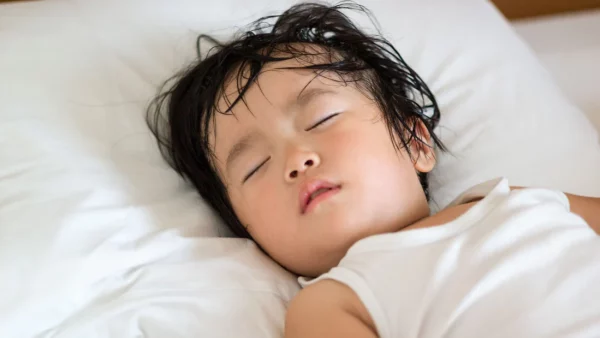Excessive night sweating in children is a condition that many parents are concerned about. While this phenomenon is often harmless, it can sometimes reflect underlying health issues that need attention. One of the primary reasons for excessive sweating in children is their underdeveloped nervous system. According to the American Academy of Pediatrics (AAP, 2020), “young children tend to sweat more during the REM phase of sleep, which accounts for 50% of their total sleep time.”
In addition, children have limited ability to regulate their body temperature. This makes them more prone to overheating when dressed in heavy clothing or sleeping in a poorly ventilated environment. The World Health Organization (WHO, 2021) recommends that the ideal room temperature for children to sleep comfortably should range from 18°C to 21°C. When this threshold is exceeded, the child’s body activates the sweating mechanism to cool down.
However, not all cases of excessive night sweating are merely environmental issues. Some instances may be linked to underlying medical conditions. A report from Johns Hopkins University School of Medicine (2019) highlights that, “night sweating accompanied by symptoms such as fever, persistent cough, or unexplained weight loss may indicate infections, metabolic disorders, or more severe illnesses like tuberculosis or pneumonia.” These cases require a medical consultation for timely diagnosis and treatment.

Another factor contributing to night sweating in children is sleep disorders. According to the Stanford Sleep Medicine Center (2020), “children experiencing disorders such as night terrors often sweat profusely due to stress responses from their nervous system.” This is a normal physiological reaction but should be closely monitored to prevent long-term psychological effects on the child.
To mitigate this condition, parents can adopt measures such as maintaining a stable room temperature, choosing lightweight, breathable fabrics for clothing and bedding, and closely monitoring for any unusual symptoms. These steps not only improve sleep quality but also support the healthy development of the child.


HPX24h > Parenting Tips > Excessive Night Sweating in Children – A Normal Occurrence or a Cause for Concern?
Top Reads from This Category
Parenting Tips
Tips for Helping Preschoolers Develop Healthy Sleep Habits
Parenting Tips
Talking To Children About Sexuality: How To Make It Easier?
Parenting Tips
Why Do Preschoolers Have the Habit of Nose Picking?
Parenting Tips
Fun Facts for 3-Year-Olds: Exploring the World of Animals and New Foods
Parenting Tips
Teaching Children Respect: Simple Tips for Parents with Kids Aged 6 to 8
Parenting Tips
Talking to Children About Race: How to Make It Easier?
Parenting Tips
Why Your Child Might Be Coughing Disruptively During Sleep?
Discover New Topics
Fitness
Which Exercise Burns the Most Calories? Tips for Choosing and Training Effectively
Healthy Eating
Effectively Lower Blood Pressure with 4 Common Kitchen Vegetables
Space
18 New Planets: Unlocking the Gateway to Exploring Giant Star Systems
Fitness
Secrets to Building Muscle with Exercise: From Technique to Habit Maintenance
Fitness
Postpartum Fitness: Secrets to Maintaining an Active Routine for a Quick Recovery
Animals
The Potential of Black Mamba Venom in Developing New Painkillers
Health
E. Coli In The Gut May Trigger A ‘Chain Reaction’ Leading To Parkinson’s Disease
Healthy Eating
Gallbladder Protection Through Diet: Expert Guide and Practical Tips
Science
NSF Job Cuts: Who Benefits and Who Bears the Consequences?
Fitness
Effective Training Tips to Enhance Muscular Endurance
Space
Exploring a New Super-Earth: Could It Support Life?
Healthy Eating
MIND Diet – The Secret to Protecting the Brain and Preventing Cognitive Decline
Uncategorized
Bài Tiếng Việt